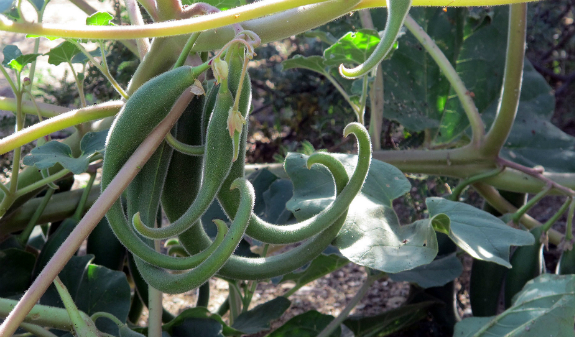
Devil’s Claw or the Unicorn Plant
June 1, 2017During the summer rainy period rather large, succulent, sticky plants are found along the floodplains and channels of arroyos throughout the Sonoran Desert. These plants have a long history of use as food and fiber by native peoples. The fruit, known as devil’s claw or in the Tohono O’odham language as “i:huk,” is cooked and eaten when young and tender as are its tasty, oily seeds. The claws are used for basket fibers, the fiber splints being very durable. I have seen baskets used in households and for feasts that have lasted for 100 years without the bottom wearing out. The color of the splints can be white, yellow, black or grey, depending on when the fruit is picked and how it is cured. The preferred red-black color is obtained by picking the fruit while it is green but when its internal fibers begin to stiffen. Waiting too long to pick the fruit results in a hard grey fiber.
Proboscidea parviflora was domesticated in the northern Sonoran Desert, probably by the Hohokam more than a thousand years ago; basketry containing Devil’s Claw has been dated to 600AD. The domesticated form has white seeds and large, long claws up to 12 inches, with three or four claws per fruit instead of two. The wild plants have claws 3-5 inches long and black seeds.
Plants of the genus Proboscidea are found throughout much of North and Central America and northern South America. All have flared tubular flowers and the distinctive horned fruit. Another local species, P. altheafolia, is a root perennial with larger yellow and orange flowers and a smaller fruit than P. parviflora, an annual with cream-burgundy flowers.
Another plant that is closely related to and probably ancestral to Devil’s Claw grows in Mexico and Central America. Martynia annua has a fruit about an inch long with little hooks growing out of its bottom. The fruit acts as a tickseed in animal hair or skin. It takes little imagination to see the fruit enlarging and growing longer hooks until it has become today’s Devil’s Claw. The larger hooks are better grabbers and hook easily onto animal legs and to human feet and ankles. The springy claws help transmit and amplify vibrations to assist the rough seeds out of the woody fruit as the animal moves about.
Devil’s Claw is a heat-loving plant, tropical in origin that likes water but is drought tolerant. In order to grow i:huk in our area, plant seeds about an inch deep between April and September 1. Adequate water will produce more and larger claws, but plants will survive with minimal water once established.
To find wild Devil’s Claws, walk along the banks and bottoms or washes; for the domesticated variety, check out the Ethnobotanical and Sin Agua Gardens here at Tohono Chul.
